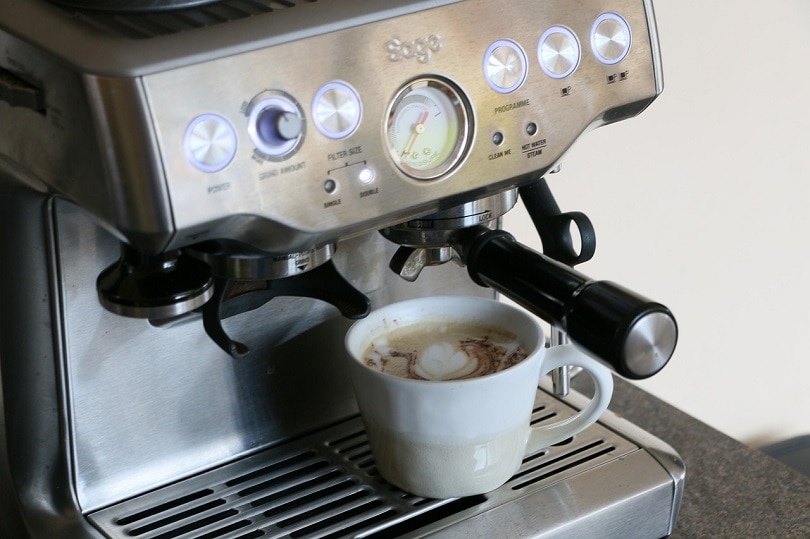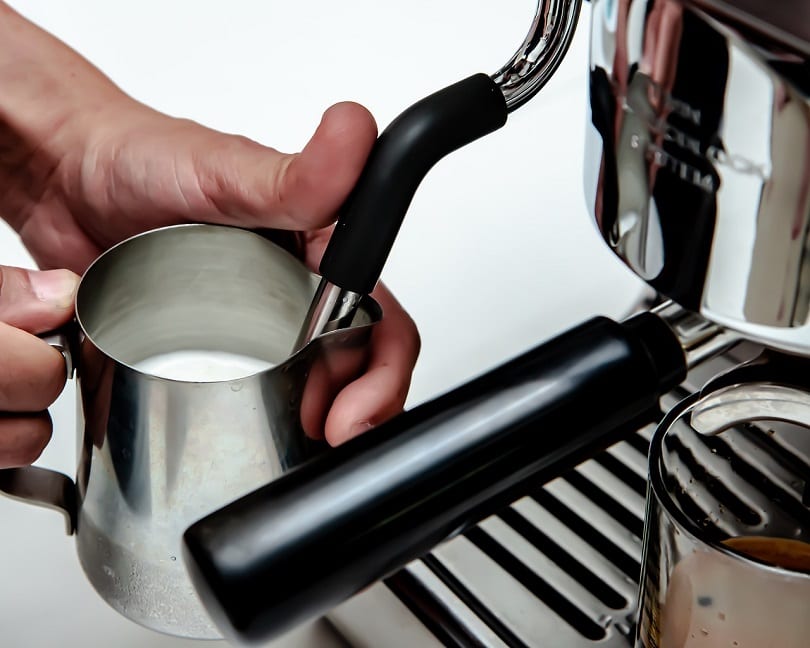
Espresso machines are all about generating pressure. Sure, water temperature and dispersion are also important, and fancy add-ons like steam wands and grinders are nice to have, but you simply do not have an espresso machine without pressure. For coffee to be considered genuine espresso, it must be brewed with at least nine bars of pressure. For reference, atmospheric pressure at sea level is right around one bar. So how do espresso machines generate almost nine times more pressure than the entire atmosphere?
In general, espresso machines use either a pump or a steam mechanism to reach the requisite nine bars and produce delicious, creamy espresso. In this article, we’re going to explain how pump espresso machines work. We will cover the basics first, describe the two most popular versions of pump espresso machines, and compare and contrast pump and steam machines. If you’ve ever wondered how your espresso machine works its magic, this article is for you.

All About That Pump
Pump espresso machines are by far the most popular style these days. They tend to be easier to use than the alternatives, less expensive, and more reliable. If you purchase an espresso machine at random from any major retailer, odds are it will be a pump machine.
In the early days of espresso, baristas generated pressure manually by pulling levers attached to pistons. The lever moved the piston and forced water out of the holding chamber, through the coffee, and into the cup. Pulling levers to make espresso is the origin of the term “pull a shot,” a phrase we still use today despite no longer using the lever design. Nowadays, espresso machines don’t run on elbow grease in favor of fancy electric pumps.

Vibration vs Rotation
Under the umbrella of pump-style espresso machines, there are two main pump designs. Both types are capable of making similar quality espresso, so which you choose depends on other factors like price, convenience, and noise level.
Vibration pumps use an ingenious electromagnetic coil design that leverages some of the weirder parts of physics. Without making this into a physics lesson, vibration pumps use a coil of wire looped around a magnetic piston to generate pressure. When an electrical current passes through the wire, the magnetic piston oscillates rapidly, driving water out of a holding chamber and through the coffee. Vibration pumps cycle about 60 times per second to create a smooth pressure profile and give you consistent results.

The other kind of pump is a rotary pump. Instead of using electromagnetic wizardry to drive the pump, rotary machines use good old-fashioned mechanical force. In rotary pump machines, a spinning disk drives a piston that pushes water through the coffee.
Both styles can make delicious espresso, so choosing between the two comes down to price and reliability. Vibration pump machines are usually cheaper and easier to maintain but don’t last as long as rotary machines. Conversely, rotary machines can get pricey, but they’re quieter than vibration pump machines and last two to three times longer.
What About Steam Machines?
Another approach to building up enough pressure to make espresso is to forgo a pump entirely and use steam instead. Steam machines were popular in the early days of espresso but have fallen out of favor in modern times due to several glaring weaknesses.

Steam machines work by boiling water and using the steam generated to create pressure. The steam pressure then forces water through the machine and your coffee. The biggest drawback to steam-style espresso machines is that they require a constant source of heat throughout the brewing process.
It is difficult to strike a balance between having hot enough water to meet the nine-bar pressure requirement and keeping the water cool enough to avoid burning the coffee. Consistency is another weak point of steam machines since the water is constantly being heated and cooled, resulting in significant pressure changes.
Some people swear by steam machines and argue that the control you get makes them superior once you overcome the steep learning curve. For most home espresso enthusiasts, steam machines are not worth the hassle, and pump machines will be easier to use and produce better coffee.
Pump Espresso Machines: Conclusion
Espresso machines are impressive feats of engineering that blend artful design with reliability. Pump machines have come a long way from using manual effort and levers to take advantage of advanced electromagnetic mechanisms and cleverly designed rotary disks.
If you’re in the market for a new espresso machine, we strongly encourage you to buy a pump machine. Both rotary-style and vibration-style machines can be a good choice depending on whether you value cost or reliability more. Steam machines are less user-friendly and will be difficult to use for most people.
OTHER INTERESTING READS:
- 15 Different Types of Espresso Machines: Which is Right for You?
- How Does an Espresso Machine Work?
- How Does an Electric Kettle Work?
- How Many Shots of Espresso Will Kill You?
Featured image credit: StockSnap, Pixabay















